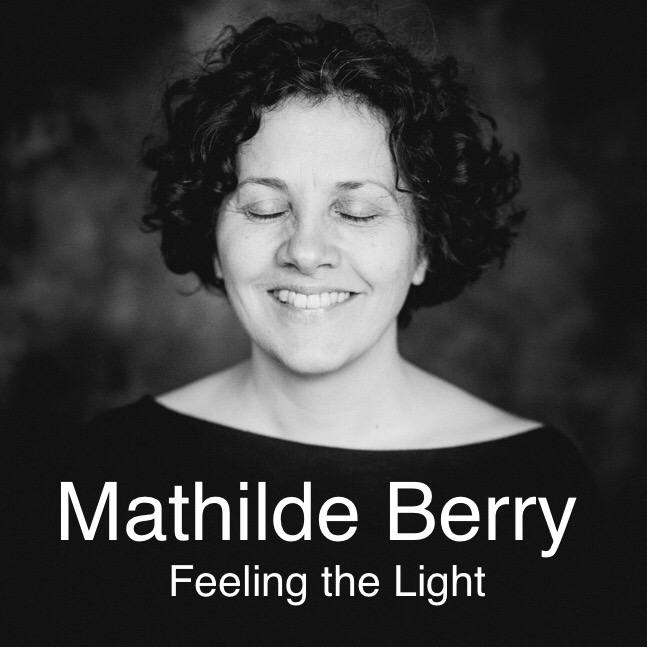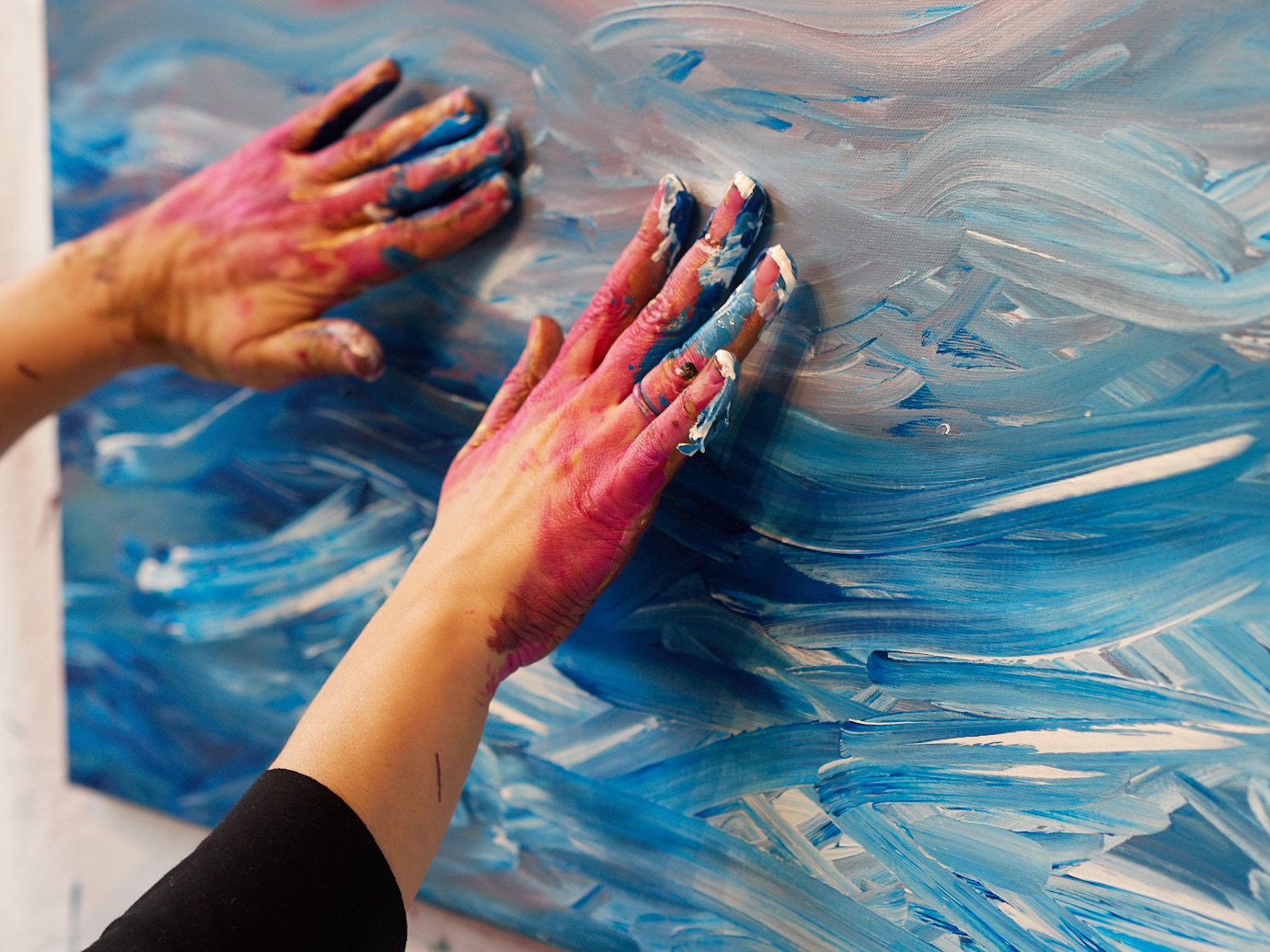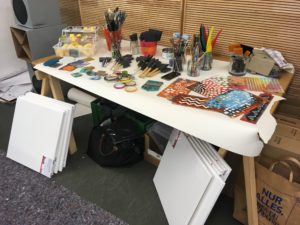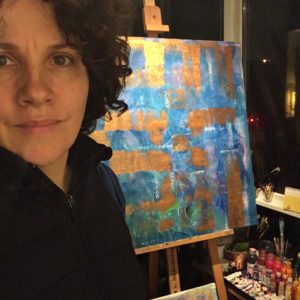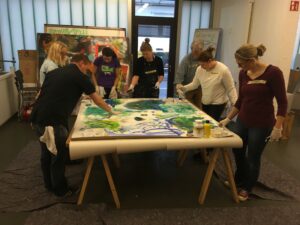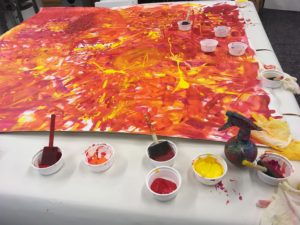This blog post is part of my blog series Behind the Scenes started in February 2018. Find out more on the previous posts and the posts to come here. I’m doing this to inspired budding artists to set up their creative space and to inform art-lovers and collectors who wonder what it takes to create a painting. Some of my personal tips are included in this post.
In this post, I’m sharing with you how I’ve come to give workshops as a volunteer to up to 22 children in a classroom.
Virtual painting sessions
I was inspired to start virtual painting sessions with an artist friend of mine, Britta, who moved away from Hamburg. We had talked about painting together, but she was in Berlin. We used to Skype every week or so and, after talking about making art over Skype, we decided to try out painting together remotely. It was a spontaneous decision, but we enjoyed it so much that over the years, we’ve planned several such “artist dates” in the comfort of our own studio.
How does a virtual painting session work?
Well, for us, it was like painting in a shared studio, each of us at the easel, the camera of our computer or tablet pointing at the canvas. We were happy to see what the other person was painting, shared tips or techniques, but mostly created in silence, knowing that the other one was there. I loved this as this made me comfortable creating with someone else around, also knowing that I would not be judged for my creative chaos, but encouraged in the best manner. My friend Britta also likes the fact that when we make our “creative dates”, we both get to make time for creativity in our lives. Since then, I’ve also had a couple more painting sessions, one with my friend Stéphanie who lives in Montréal and I have another one in the pipeline with Achille who lives near Vancouver… For me, these painting sessions allow me to share our respective processes with an artistic tribe beyond Hamburg!
Tip number 1: What you’ll need for a virtual painting session
a) make sure that you both have all the materials you need for a smooth session – because you won’t be able to share materials remotely alas 😉
b) have your power cable ready, because it’s not much fun to look for it with the hands full of paint as that happens to me regularly
c) try out a good spot for your computer or tablet in the studio before you start your session
d) have a protection for your computer keyboard ready (a transparent thin plastic layer over it or clean gloves) in case of paint splashes
e) I like to put my iPad on a tripod for stability. It’s also easier to move the iPad around to move it in the studio to share close-up details of my work
In my painting session with Stéphanie, I realised that I was able to share some of my tips and tricks with her easily although she was thousands of miles away, so I’ve decided to offer virtual painting sessions on an individual basis to people interested. Please contact me if you’d like to hear more about it.
I also offer virtual tours of my atelier in a similar fashion, iPad in hand or on a tripod, I’ll share with you some of my latest works including close ups. That’s how my friend Achille in British Columbia and Anne-Christine in Belgium first visited my studio.
Welcome in my studio!
I’ve started giving impromptu workshops to friends of mine who were visiting me in person. Many a brunch party finished with us crammed with up to 2 adults and 3 children in my tiny space… or expanding into the living room cum showroom. My friend Sandra and her sons Vincent and Jasper were the very first guests to step into my studio after my daughter Charlotte, already in Spring 2015, followed by Michèle and her daughter Marlène and most recently Lydie and Morgiane.
The positive feedback that I received in those creative afternoons have inspired me to offer workshops to adults and children alike.
I’ve also made space to allow acquaintances to discover or rediscover their own creativity. A beautiful example for this is Christine who has come twice to explore her own creativity and take home her own creations and finish them in her own space. I loved to see how she truly unleashed her creative potential and left my studio with a huge smile on her face, paint on her hands and several canvases under her arm.
After that, I felt ready to open my studio to people whom I didn’t know very well.
Tip number 2: to open your studio to others, you’ll have to let go of the fact that you can’t control how your tools will be handled, how your space may be used, so make sure you’re ready for what can seem like an “invasion of your creative space”. Only if you feel really good about that should you open your studio to other creative souls. If not, make space elsewhere for these painting sessions or workshops.
Tip number 3: protection!
a) have old t-shirts, shirts, aprons, rags, gloves and over-shoe / over-socks available in your studio before you start – if you work with acrylic paint, that won’t come off clothes and you’ll need to thoroughly scrub your skin if it dries on it!
b) have large sheets of paper or better, industrial room protection for your furniture and your floor
c) do a kind of “safety round” – particularly with children – in a playful way please!! – to protect your materials. Ask them: “what do I with my brush after using it?”, “where do I put the paint and the tools?” – even if you just say: “dump it in the container with water”, “put it on the protective paper” and “remember to keep your hands full of paint away from the living room curtains” – depending on the age group of course 😉
Group workshops
For the first time this year, I had the privilege to guide a group of 8 adults through a workshop on intuitive painting in the Esche Stiftung in Hamburg and thoroughly enjoyed it. You can read all about it here.
I found so much joy in giving this workshop! If you’d like to give a workshop yourself, I’d recommend a couple of things for before and after the workshop.
Tip number 4: On organisation…
a) Make sure that you choose/visit the room before and know what’s allowed and what’s not allowed by the owners of the space. Art rooms are always a good start!
b) Communicate beforehand with the organisers on the objectives and flow of the workshop, adjust as necessary, decide on timing and materials and on protective clothing and have a paragraph ready to share
c) if you run a workshop for a larger group of people, talk budget with the organisers and who buys and who brings what on the day – particularly if outside the studio
d) organise suitable boxes/containers for transport and a vehicle (I don’t have a car, so this one is critical for me)
e) have inspiring music ready to play – a playlist and a boombox are great – for ask participants to bring inspiring music for them. Music has the power to unleash creative blocks and helps people to “come out of their heads and into the body”
My daughter’s teacher loves art, so when we talked at the teacher-parent evening last year, I agreed to run a two-hour workshop for the children in first year of school. I had prepared in advance a topic and they really loved it, so much so that they asked me to come back this year and I even repeated my first workshop with two other classes.
Tip number 5: For workshops with children: listen and adapt to the space and environment
a) what you can do with schoolchildren in your own studio or in the classroom will differ greatly – unless you manage to use the art classroom
b) bring some of your creations (e.g. my art notebooks with doodles, collages and watercolour essays) take your catalogue and be prepared to be drilled with questions – I loved the “are you famous?” question that I was asked two years ago… I answered: “…not yet, but I love making art”
c) it’s all about the process, being positive and encouraging to explore one’s creativity. I’ve already heard “but I can’t draw”… My answer now: “don’t compare yourself to anybody. Only you can draw like you do, that’s what makes your drawing unique”.
d) make sure you have a helping hand or several if you give workshops to more than 4 people. I loved giving a workshop to 8 adults in April, but I realised that I was pretty exhausted afterwards. You need to give your attention to each person and you don’t want to have to worry about cleaning behind any paint spills or worry about discipline during your workshop. Having adult volunteers at a workshop with more than a dozen active 11-12 years old children last weekend was so helpful, to set up the room and clear it afterwards.
